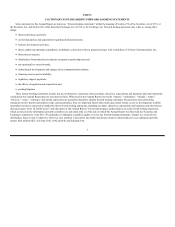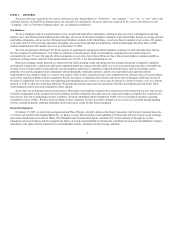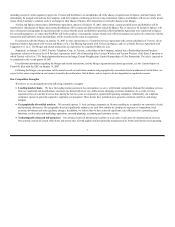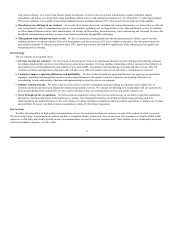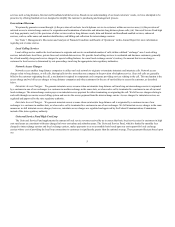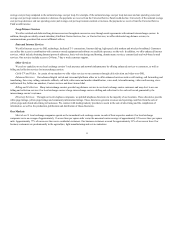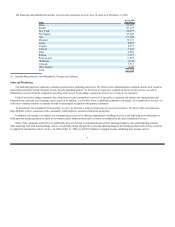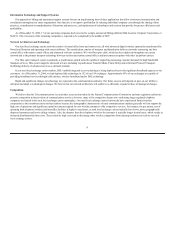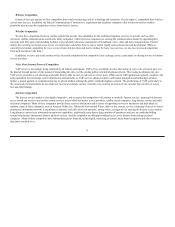FairPoint Communications 2006 Annual Report Download - page 13
Download and view the complete annual report
Please find page 13 of the 2006 FairPoint Communications annual report below. You can navigate through the pages in the report by either clicking on the pages listed below, or by using the keyword search tool below to find specific information within the annual report.
We believe that competition in our telephone service areas will increase in the future as a result of the Telecommunications Act and through increased
deployment of various types of technology, although the ultimate form and degree of competition cannot be ascertained at this time. Competition may lead to
loss of revenues and profitability as a result of: loss of customers; reduced usage of our network by our existing customers who may use alternative providers
for long distance, voice and data services; and reductions in prices for our services which may be necessary to meet competition.
Federal Regulation
We must comply with the Communications Act which requires, among other things, that communications carriers offer services at just and reasonable
rates and on non-discriminatory terms and conditions. The amendments to the Communications Act contained in the Telecommunications Act dramatically
changed the landscape of the communications industry. The central aim of the Telecommunications Act was to open local communications marketplaces to
competition while enhancing universal service. Most significantly, the Telecommunications Act governs the removal of barriers to market entry into local
telephone services, requires incumbent local exchange carriers to interconnect with competitors, establishes procedures pursuant to which incumbent local
exchange carriers may provide other services, such as the provision of long distance services by regional Bell operating companies, and imposes on incumbent
local exchange carriers duties to negotiate interconnection arrangements in good faith.
Prior to the enactment of the Telecommunications Act, many states limited the services that could be offered by a company
competing with an incumbent local exchange carrier. The Telecommunications Act generally preempts state and local laws that prevent competitive entry into
the provision of any communications service. However, states can modify conditions of entry into areas served by rural local exchange carriers where the state
regulatory commission determines that such modification is warranted by the public interest. Since the passage of the Telecommunications Act, we have
experienced limited wireline competition from cable providers, however recently cable service providers have been introducing VoIP local service offerings that
may increase their ability to compete for residential customer lines, and we have experienced increasing competition from wireless service providers.
The Federal Communications Commission regulates the prices that incumbent local telephone companies charge for the use of their
local telephone facilities in originating or terminating interstate transmissions. The Federal Communications Commission has structured these prices, also
referred to as “access charges,” as a combination of flat monthly charges paid by the end-users and usage sensitive charges paid by long distance carriers.
State regulatory commissions regulate intrastate access charges. Many states generally mirror the Federal Communications Commission price structure. A
significant amount of our revenues come from network access charges, which are paid to us by intrastate and interstate long distance carriers for originating
and terminating calls in the regions served by our rural local exchange carriers. The amount of access charge revenues that we receive is based on rates set by
federal and state regulatory bodies, and such rates are subject to change at any time.
The Federal Communications Commission regulates the levels of interstate access charges by imposing price caps on larger incumbent local telephone
companies. These price caps can be adjusted based on various formulae, such as inflation and productivity, and otherwise through regulatory proceedings.
Smaller incumbents may elect to base access charges on price caps, but are not required to do so unless they elected to use price caps in the past or their
affiliated incumbent local telephone companies base their access charges on price caps. Each of our 31 local telephone subsidiaries elected not to apply the
Federal Communications Commission’s price caps. Instead, our subsidiaries employ rate-of-return regulation for their interstate access charges.
11


